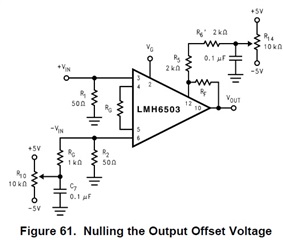Other Parts Discussed in Thread: VCA822, VCA820, VCA824
Hello, on page 19 of LMH6503 daatasheet, Figure 61 shows how to adjust (on pin 12) the output offset of the LMH6503 IC. Can this adjustment be useful to adjust the offset from 0Vdc to +/- 5 Vdc when the LMH6503 is powered at +/- 12V? Thanks.
Regards


